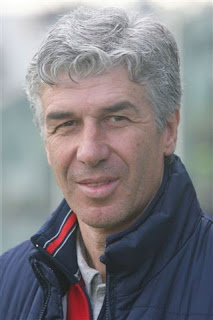By Jeremy Culley
‘His Majesty Wayne Rooney had to run into the Nerazzure mouths of a hungry goddess, who makes a morsel of the soft Toffees of Liverpool’ was the triumphant declaration from the iconic Italian daily Gazzetta dello Sport.
 |
| 'His Majesty' Wayne Rooney |
English audiences unsure what to expect as Everton travelled to Italy last night will be under no illusions now, after Rooney and co were so convincingly thumped.
This was the final stage of the rebirth of Atalanta, the Bergamo club making their first foray into European competition since 1991.
The club will be familiar to British fans hooked by Football Italia on Channel 4 in the 90s and noughties, but few would associate it with anything remotely resembling success.
They have perennially been little more than fodder to be brushed aside by the likes of Juventus, Roma, AC Milan and Internazionale.
So this renaissance of ‘La Dea’, or ‘the Goddess’, a nickname stemming from the club being named after the Greek huntress, has something almost mythological about it.
Not least on Thursday as their fans had to traipse 120 miles south to Reggio Emilia to take in the historic occasion, while the ageing Stadio Atleti d’Azzurri Italia in Bergamo is refurbished to meet UEFA regulations.
Being forced into unfamiliar surroundings would surely be a leveller for Everton to seize upon against the Italian upstarts?
Never.
The thousands who travelled turned the temporary home into a cauldron, Atalanta’s fans oozing the optimism and confidence generated last season when the Bergamaschi defied expectations by finishing fourth in Serie A to qualify for the Europa League.
They symbolically finished ahead of both neighbouring Milanese giants, so often having watched their illustrious rivals Inter and Milan hog the limelight.
In 1991, appropriately enough it was Inter who defeated Atalanta 2-0 at the UEFA Cup’s quarter-final stage, sentencing them to a quarter of a century in the European footballing wilderness.
How sweet the Peroni must have tasted in the bars of the Città Alta last night, and back in May when Atalanta finished nine points ahead of Milan and 10 clear of Inter.
Everton were dreadful, their manager Ronald Koeman withering of his players’ efforts, yet their colossal £130m summer spending spree, notwithstanding the free transfer of Rooney, dwarfs the modest outlay spent on the Atalanta revolution.
Andrea Petagna, the pacy scourge of Everton last night, was plucked from AC Milan at a bargain price after spells on loan in Serie B.
Marten de Roon, a £12m Middlesbrough buy ahead of last year’s Premier League season, flopped on Teesside and returned to Bergamo.
And Andreas Cornelius, Cardiff City’s record £7.5m buy in their maiden season in the top flight, was a disaster of such epic proportions in south Wales he left after just six months.
All three, especially the wonderful, electric Petagna, are now integral to Gian Piero Gasperini’s side, which continues to confound doubters.
Gasperini himself, a journeyman manager now at 59, has a somewhat chequered record.
Success with Crotone and Genoa earned him the opportunity to revive the fortunes of Atalanta’s neighbours Inter.
He took the helm just over a year on from José Mourinho’s Champions League triumph in 2010, after which a poor period under Rafa Benitez had led to a decline in fortunes.
Gasperini fared disastrously in trying to arrest the slide and was sacked after just five matches in charge, losing four of them.
Rather aptly, the Italian media routinely referred to him as ‘Gasp’ in headlines, such was the panic that seemed to be engulfing San Siro.
It left Gasperini with a career to resurrect, his stock having taken a pounding, and the recent success of Atalanta is as much a story of his revival as it is the club’s.
The giants of Inter, Roma and Napoli departed Bergamo empty-handed last season as Atalanta surged to six straight wins in October and November.
All season, defeats were rare, with AC Milan and Juventus also unable to claim victory at the intimidating Atleti d’Azzurri.
The Argentine winger Alejandro Gomez, another astute purchase, from the Ukrainians Metalist Kharkiv, was the star, bagging 16 goals and earning a maiden cap for his country in the process.
Much-needed improvements to Atalanta’s home ground are now on the agenda, after the club bought the stadium – still quite a rarity in Italy – from the local council.
Such upbeat signs are a far cry from seven years ago.
As Inter celebrated Champions League glory, their neighbours in Bergamo were relegated to Serie B, suffering two heavy defeats to their rivals at San Siro before Napoli nailed the coffin lid shut with a 2-0 win on the penultimate weekend.
It was a third relegation in seven years, with real fears voiced for the club’s future, both financially and on the pitch.
But an immediate promotion and successive seasons of survival have shored up the club, with Atalanta heavy reliant on bargain buys and academy graduates to be competitive.
The superb Petagna might not strictly be an Atalanta product but it is they who have catapulted him into the limelight.
He follows an illustrious line of players to have blossomed in Bergamo, with Filippo Inzaghi, Christian Vieri, Paolo Montero and Roberto Donadoni among a star-studded list.
The sale of these stars has always been a necessary evil to keep the club afloat.
Such prudence explains why the Bergamaschi have endured such a long wait for silverware; the 1963 Coppa Italia triumph remains Atalanta’s solitary major trophy.
But perhaps now – possibly even through the Europa League – the wait for a trophy may end.
Certainly the only ‘gasps’ from watching pundits now are in admiration for the job Gian Piero is doing in Bergamo.
‘The Toffees of Liverpool’ are merely one of many teams to come unstuck against the new, brilliant Atalanta.
See Best of Bergamo’s updated Flights Guide



